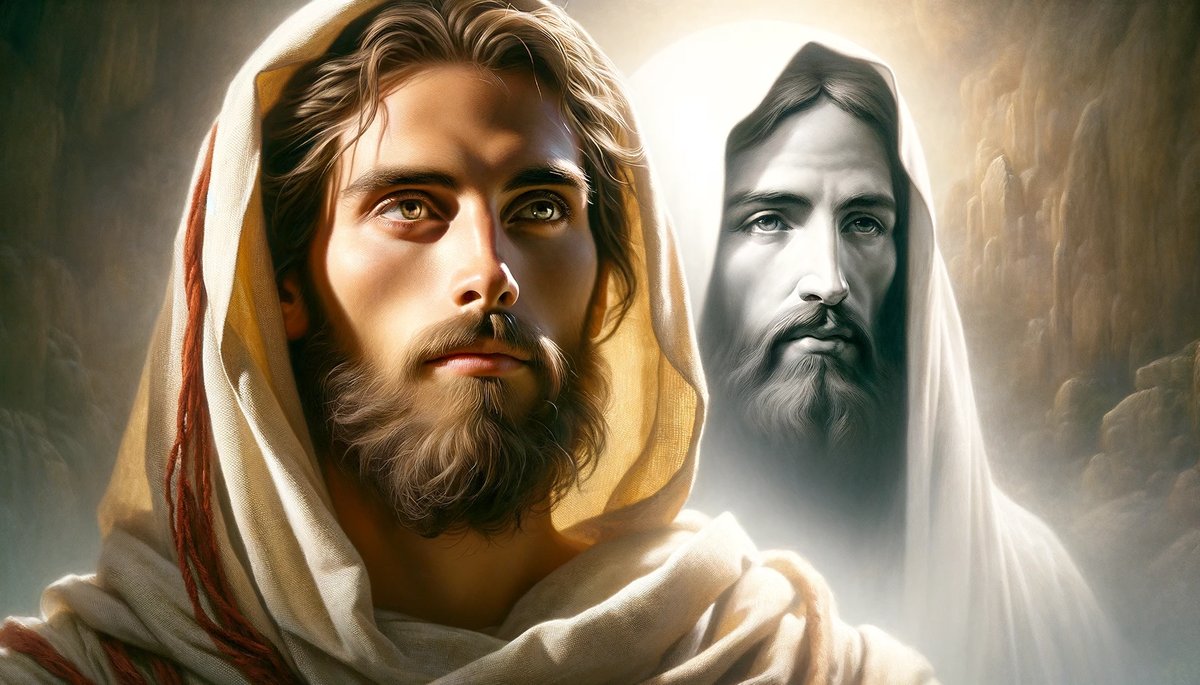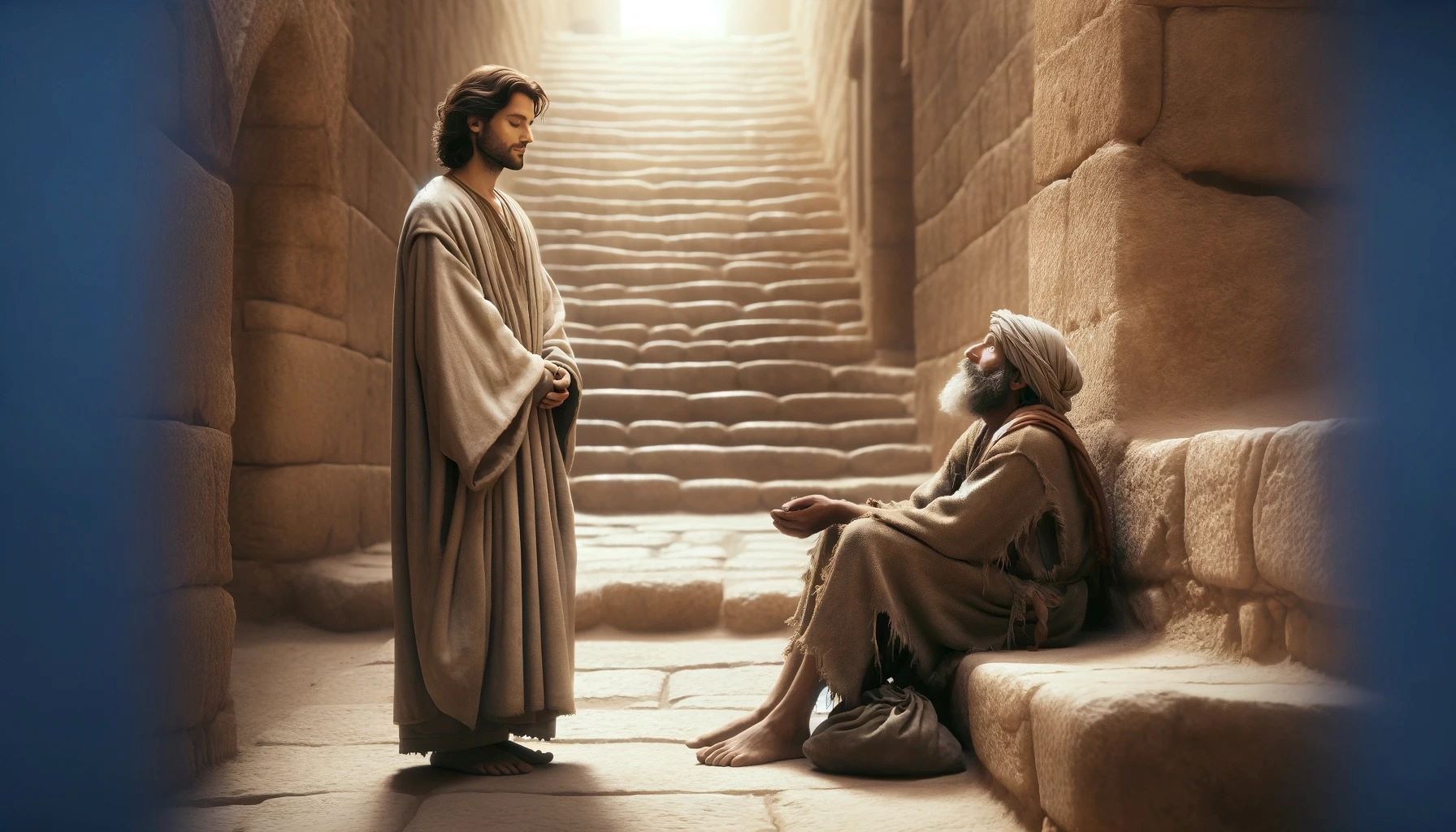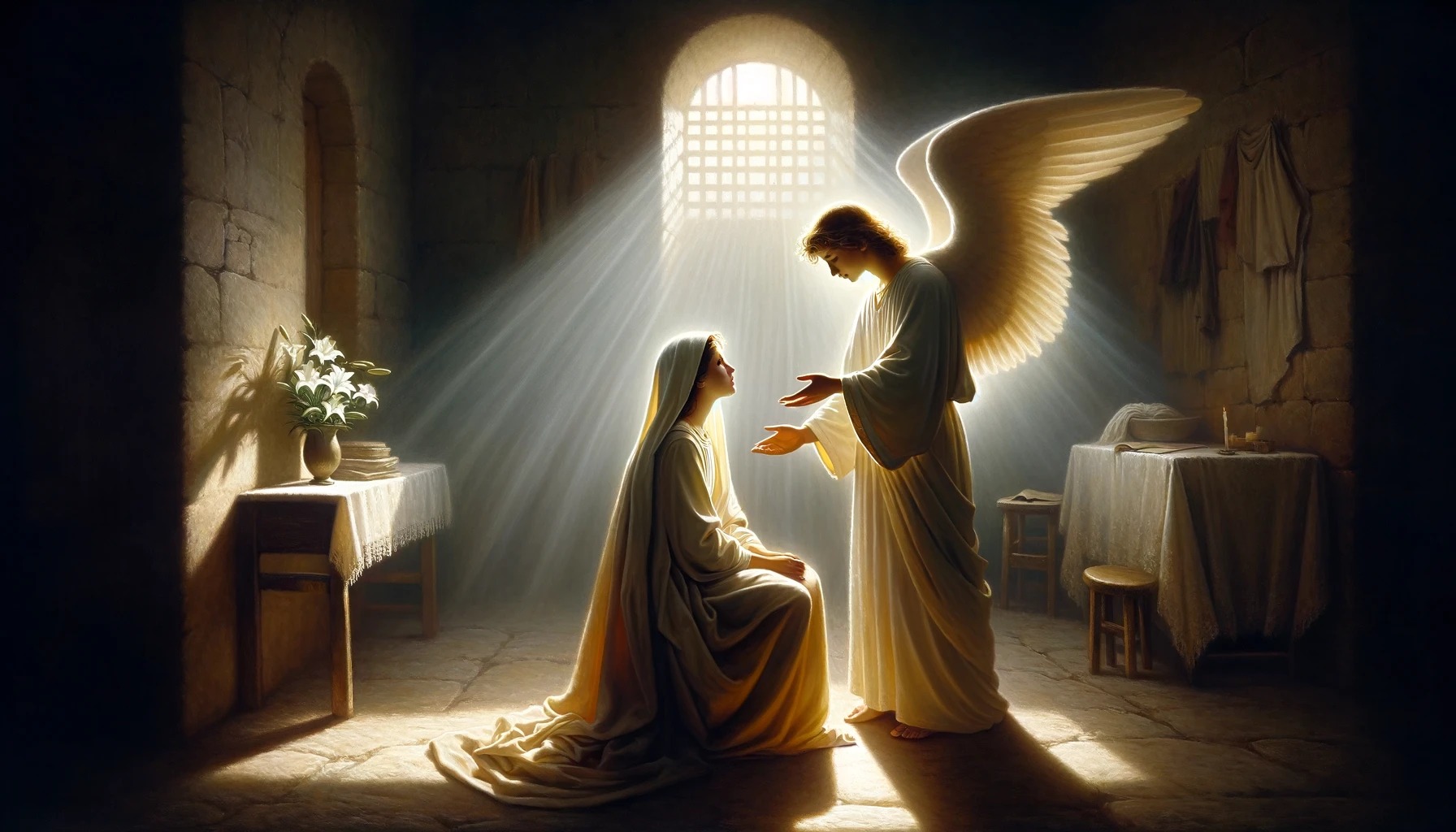Home>Christian Videos>Bible Stories>How Is Jesus Christ Portrayed In Each Chapter Of The Book Of John


Bible Stories
How Is Jesus Christ Portrayed In Each Chapter Of The Book Of John
Published: March 2, 2024
Peter Smith, Editorial Director at Christian.net, combines deep insights into faith, politics, and culture to lead content creation that resonates widely. Awarded for his contributions to religious discourse, he previously headed a major organization for religious communicators, enhancing dialogue on faith's societal impacts.
Explore the portrayal of Jesus Christ in each chapter of the Book of John. Gain insight into the captivating and timeless Bible stories. Discover the profound impact of Jesus' teachings and miracles.
(Many of the links in this article redirect to a specific reviewed product. Your purchase of these products through affiliate links helps to generate commission for Christian.net, at no extra cost. Learn more)
Table of Contents
- Introduction
- Chapter 1: The Word Made Flesh
- Chapter 2: The Wedding at Cana
- Chapter 3: Nicodemus and the New Birth
- Chapter 4: The Woman at the Well
- Chapter 5: The Healing at the Pool of Bethesda
- Chapter 6: Feeding the Five Thousand
- Chapter 7: Jesus at the Feast of Tabernacles
- Chapter 8: The Woman Caught in Adultery
- Chapter 9: Healing the Man Born Blind
- Chapter 10: The Good Shepherd
- Chapter 11: The Raising of Lazarus
- Chapter 12: The Triumphal Entry
- Chapter 13: The Last Supper
- Chapter 14: Jesus the Way, the Truth, and the Life
- Chapter 15: The Vine and the Branches
- Chapter 16: The Promise of the Holy Spirit
- Chapter 17: Jesus' High Priestly Prayer
- Chapter 18: The Betrayal and Arrest of Jesus
- Chapter 19: The Crucifixion
- Chapter 20: The Resurrection
- Chapter 21: Jesus Appears to the Disciples
Introduction
The portrayal of Jesus Christ in the Book of John is a captivating and multifaceted journey that reveals the various aspects of his character, teachings, and divine nature. Each chapter in the Book of John offers a unique perspective on Jesus, shedding light on his miracles, interactions with people, and profound teachings. Exploring how Jesus is depicted in each chapter provides a deeper understanding of his significance and impact on the world. Let's delve into the diverse portrayals of Jesus Christ in the Book of John and unravel the timeless wisdom encapsulated in these narratives.
Read more: How Many Chapters In Book Of Revelation
Chapter 1: The Word Made Flesh
-
The Incarnation of the Word: In the opening chapter of the Book of John, Jesus is portrayed as the eternal Word of God who became flesh and dwelt among humanity. This chapter introduces the profound concept of the Incarnation, emphasizing the divine nature of Jesus Christ. It highlights the preexistence of Jesus as the Word who was with God and was God from the beginning of creation.
-
The Light of the World: John chapter 1 also presents Jesus as the Light that shines in the darkness, symbolizing his role in dispelling spiritual ignorance and bringing illumination to humanity. This portrayal underscores Jesus' significance as the source of divine truth and spiritual enlightenment, offering hope and guidance to those who embrace his teachings.
-
The Rejection and Acceptance of the Word: The chapter further depicts the contrasting responses to the Word made flesh, illustrating how some rejected Jesus while others received him. This theme sets the stage for the unfolding narrative of Jesus' ministry, revealing the profound impact of his presence on individuals and communities.
-
The Fulfillment of Prophecy: Additionally, the chapter emphasizes the fulfillment of Old Testament prophecies in the person of Jesus Christ, underscoring his role as the long-awaited Messiah and Savior. This portrayal establishes a powerful connection between the Old Testament scriptures and the life of Jesus, affirming his divine mission and redemptive purpose.
-
The Grace and Truth of Jesus: Finally, John chapter 1 highlights the abundant grace and truth that come through Jesus Christ, portraying him as the embodiment of God's unmerited favor and ultimate revelation. This portrayal sets the tone for the subsequent chapters, showcasing the transformative impact of encountering the Word made flesh.
The portrayal of Jesus in the first chapter of the Book of John lays a foundational framework for understanding his divine nature, redemptive mission, and profound impact on humanity. It sets the stage for the unfolding narrative of Jesus' ministry, inviting readers to contemplate the significance of the Incarnation and embrace the transformative power of encountering the Word made flesh.
Chapter 2: The Wedding at Cana
-
The First Miracle: The second chapter of the Book of John unveils a significant portrayal of Jesus through the account of the Wedding at Cana. This narrative marks the beginning of Jesus' public ministry and showcases his divine power in performing miracles. The transformation of water into wine at the wedding feast serves as the inaugural miracle attributed to Jesus, revealing his capacity to bring about extraordinary and unexpected blessings in the midst of ordinary circumstances.
-
Abundance and Celebration: The Wedding at Cana also highlights Jesus' inclination towards abundance and joyous celebration. By providing an abundance of the finest wine when the supply ran out, Jesus demonstrates his desire for people to experience the fullness of life and the richness of God's blessings. This portrayal emphasizes Jesus' role in bringing fulfillment and joy to human experiences, symbolizing his capacity to transform scarcity into abundance.
-
Revealing His Glory: Furthermore, the miracle at Cana serves as a revelation of Jesus' glory and divine authority. The chapter underscores the significance of this miraculous event as a manifestation of Jesus' identity as the Son of God, eliciting belief and faith in those who witnessed the extraordinary transformation. This portrayal sets the stage for the unfolding revelation of Jesus' divine nature and his mission to bring about spiritual transformation and renewal.
-
Symbolism of New Beginnings: The Wedding at Cana also carries profound symbolism, representing the concept of new beginnings and the arrival of the Messianic age. The transformation of water into wine symbolizes the transition from the old covenant to the new covenant, signifying the arrival of spiritual fulfillment and the inauguration of a new era through the ministry of Jesus Christ. This portrayal underscores the transformative power of encountering Jesus and the ushering in of a new paradigm of grace and redemption.
-
The Significance of Faith: Additionally, the narrative of the Wedding at Cana emphasizes the importance of faith and obedience in experiencing the miraculous work of Jesus. The chapter highlights the role of Mary, the mother of Jesus, in prompting the miracle through her implicit trust in her son's ability to intervene. This portrayal underscores the interconnectedness of faith, divine intervention, and the manifestation of God's power in the lives of believers.
The portrayal of Jesus in the Wedding at Cana chapter of the Book of John encapsulates his capacity to bring about transformation, abundance, and spiritual renewal. It serves as a compelling testament to his divine authority, his inclination towards joyous celebration, and the significance of faith in experiencing the miraculous manifestations of his power.
Chapter 3: Nicodemus and the New Birth
-
The Encounter with Nicodemus: In the third chapter of the Book of John, the narrative of Jesus' encounter with Nicodemus unfolds, revealing profound insights into the concept of spiritual rebirth and the transformative power of faith. Nicodemus, a Pharisee and a member of the Jewish ruling council, approaches Jesus under the cover of night, seeking to understand the nature of Jesus' teachings and his identity as a divine teacher.
-
The Concept of Spiritual Rebirth: Jesus' conversation with Nicodemus delves into the concept of being "born again" or "born from above," emphasizing the necessity of spiritual regeneration for entering the kingdom of God. This portrayal underscores the transformative nature of encountering Jesus and embracing the message of salvation, highlighting the need for a profound inward renewal and a shift in one's spiritual orientation.
-
The Role of Faith and the Spirit: The dialogue between Jesus and Nicodemus emphasizes the pivotal role of faith and the work of the Holy Spirit in the process of spiritual rebirth. Jesus elucidates the concept of being born of water and the Spirit, signifying the cleansing and renewing work of the Holy Spirit in the lives of believers. This portrayal underscores the indispensable role of faith and the divine agency in bringing about spiritual transformation and newness of life.
-
The Unveiling of God's Love and Salvation: Furthermore, the encounter with Nicodemus serves as a revelation of God's profound love for humanity and his redemptive purpose. Jesus' declaration of God's love for the world and his mission to bring salvation through the Son illuminates the universal scope of God's redemptive plan, inviting individuals to embrace the message of hope and reconciliation. This portrayal underscores the inclusive nature of God's love and the accessibility of salvation through faith in Jesus Christ.
-
The Invitation to Embrace New Life: The narrative of Nicodemus and the new birth extends an invitation to all individuals to embrace the transformative power of faith and experience spiritual renewal. It emphasizes the universal relevance of Jesus' message of new birth, extending beyond cultural, religious, and societal boundaries. This portrayal invites readers to contemplate the significance of spiritual rebirth and the invitation to enter into a renewed relationship with God through faith in Jesus Christ.
The portrayal of Jesus in the encounter with Nicodemus in the Book of John underscores the transformative nature of spiritual rebirth, the pivotal role of faith and the Holy Spirit, and the universal invitation to embrace God's redemptive love and salvation. It serves as a compelling testament to the inclusive and transformative nature of Jesus' message, inviting individuals to embark on a journey of spiritual renewal and newness of life.
Chapter 4: The Woman at the Well
-
Encounter at the Well: The fourth chapter of the Book of John unfolds the poignant encounter between Jesus and the Samaritan woman at the well. This narrative portrays Jesus' willingness to engage with an outsider and demonstrates his radical inclusivity, transcending social and cultural barriers. The interaction takes place at Jacob's well, where Jesus, weary from his journey, initiates a conversation with the woman, challenging societal norms and revealing his profound understanding of human nature.
-
Revelation of Living Water: Through the dialogue with the Samaritan woman, Jesus introduces the concept of "living water," symbolizing the spiritual sustenance and eternal life that he offers. This portrayal underscores Jesus' role as the source of spiritual nourishment and the embodiment of divine grace, inviting individuals to partake in the life-giving waters that quench the deepest longings of the human soul.
-
Recognition of the Messiah: The narrative also unfolds the woman's gradual recognition of Jesus as the Messiah, culminating in her acknowledgment of his prophetic insight into her personal history. This portrayal highlights Jesus' ability to perceive the innermost realities of individuals and his capacity to bring about transformative encounters that lead to profound spiritual awakening and revelation.
-
Breaking Down Barriers: Furthermore, the encounter at the well serves as a catalyst for breaking down cultural and religious barriers, as Jesus extends his message of salvation to the Samaritan community. This portrayal emphasizes Jesus' mission to reconcile diverse groups and invite all people, regardless of their background, to partake in the redemptive work of God, transcending societal prejudices and divisions.
-
Empowerment and Witness: The narrative of the woman at the well also illustrates the transformative impact of encountering Jesus, as the woman becomes an empowered witness, sharing her experience with others and inviting them to encounter the Messiah. This portrayal underscores the profound influence of personal encounters with Jesus in igniting a passion for sharing the message of hope and redemption with others, embodying the transformative power of faith.
The portrayal of Jesus in the encounter with the woman at the well in the Book of John encapsulates his radical inclusivity, the offer of living water, the recognition of his messianic identity, the breaking down of societal barriers, and the transformative empowerment of individuals to become witnesses of his redemptive message. It serves as a compelling testament to Jesus' universal invitation to partake in the life-giving waters of grace and to transcend cultural, social, and religious boundaries through encounters with the living Christ.
Read more: How Do Each Of The Gospels Portray Jesus
Chapter 5: The Healing at the Pool of Bethesda
-
The Context of Suffering: The fifth chapter of the Book of John presents a poignant account of Jesus' healing at the Pool of Bethesda, where a multitude of people with various infirmities gathered, hoping for a miraculous cure. This narrative unfolds against the backdrop of human suffering, portraying the physical, emotional, and spiritual struggles faced by those in need of healing.
-
The Encounter with the Paralytic: The chapter depicts Jesus' encounter with a man who had been paralyzed for thirty-eight years, highlighting the man's prolonged suffering and his longing for restoration. Jesus' compassionate interaction with the paralytic underscores his deep empathy for those enduring affliction, revealing his desire to bring about wholeness and liberation from the grip of infirmity.
-
The Power of Restoration: Through the healing at the Pool of Bethesda, Jesus demonstrates his authority to bring about miraculous restoration and transformation. The instantaneous cure of the paralytic symbolizes Jesus' capacity to release individuals from the bondage of physical and spiritual ailments, offering a profound testament to his divine power and compassion.
-
Challenging Religious Norms: The narrative also challenges religious norms and traditions, as Jesus performs the healing on the Sabbath, eliciting criticism and opposition from the religious authorities. This portrayal underscores Jesus' willingness to confront legalistic interpretations of religious laws and his prioritization of alleviating human suffering over adherence to rigid regulations.
-
The Invitation to Wholeness: The healing at the Pool of Bethesda extends an invitation to all individuals to embrace the transformative power of Jesus' compassion and restoration. It serves as a compelling testament to Jesus' mission to bring about spiritual and physical wholeness, transcending the limitations of human affliction and offering the promise of liberation to those in need.
The portrayal of Jesus in the healing at the Pool of Bethesda chapter of the Book of John encapsulates his compassion for the suffering, his authority to bring about restoration, his willingness to challenge religious norms, and the universal invitation to embrace the transformative power of his healing grace. It serves as a poignant testament to Jesus' capacity to bring about liberation from affliction and to offer the promise of wholeness to all who seek his transformative touch.
Chapter 6: Feeding the Five Thousand
-
Abundance in Scarcity: The sixth chapter of the Book of John unveils the miraculous feeding of the five thousand, a profound portrayal of Jesus' ability to provide abundance in the midst of scarcity. The narrative unfolds with a large crowd following Jesus to a remote place, where the challenge of feeding the multitude becomes apparent. Despite the apparent scarcity of resources, Jesus demonstrates his capacity to multiply a meager supply of five loaves and two fish, providing an abundance of food that satisfies the hunger of the entire assembly.
-
Symbolism of Provision: The feeding of the five thousand carries profound symbolism, representing Jesus' role as the ultimate provider and sustainer of spiritual nourishment. The miraculous multiplication of bread and fish underscores Jesus' ability to meet the deepest needs of humanity, offering sustenance for both the physical and spiritual hunger experienced by the crowd. This portrayal emphasizes Jesus' capacity to transcend limitations and provide for the abundant well-being of those who seek his provision.
-
Divine Compassion and Generosity: Furthermore, the narrative highlights Jesus' divine compassion and generosity, as he attends to the physical needs of the multitude with unwavering care and concern. His willingness to address the hunger of the crowd reflects his profound empathy for human suffering and his desire to alleviate the immediate needs of those in his midst. This portrayal underscores Jesus' inclination towards acts of compassion and his capacity to transform scarcity into plenitude through his divine intervention.
-
The Disciples' Participation: The narrative also involves the disciples in the distribution of the multiplied provisions, inviting them to participate in the miraculous act of provision. This portrayal underscores the disciples' role as conduits of Jesus' abundant grace and their involvement in extending the blessings of his provision to the multitude. It emphasizes the collaborative nature of Jesus' ministry and the invitation for his followers to partake in the dissemination of his transformative abundance.
-
The Invitation to Spiritual Nourishment: The feeding of the five thousand extends an invitation to all individuals to partake in the spiritual nourishment offered by Jesus Christ. It serves as a compelling testament to his capacity to provide sustenance for the deepest longings of the human soul, transcending the limitations of earthly scarcity and offering the promise of spiritual abundance. This portrayal invites readers to contemplate the significance of encountering Jesus as the ultimate provider of nourishment for the body, mind, and spirit.
The portrayal of Jesus in the feeding of the five thousand chapter of the Book of John encapsulates his ability to provide abundance in scarcity, the symbolism of his provision, his divine compassion and generosity, the disciples' participation in his ministry, and the universal invitation to partake in the spiritual nourishment offered by the living Christ. It serves as a profound testament to Jesus' capacity to meet the multifaceted needs of humanity and to offer the promise of abundance in every aspect of life.
Chapter 7: Jesus at the Feast of Tabernacles
-
The Setting of the Feast: The seventh chapter of the Book of John unfolds with Jesus' presence at the Feast of Tabernacles, a significant annual celebration in Jerusalem. The festival commemorates the Israelites' journey through the wilderness and serves as a time of rejoicing and thanksgiving for God's provision. Jesus' participation in this festive occasion sets the stage for profound encounters and teachings that unfold amidst the vibrant backdrop of the celebration.
-
Teachings on Living Water: During the Feast of Tabernacles, Jesus delivers a compelling discourse on the concept of living water, drawing from the symbolism of the water libation ceremony that was part of the festival's rituals. His proclamation of being the source of living water resonates with the spiritual significance of the feast, emphasizing his role as the ultimate provider of sustenance and spiritual refreshment. This portrayal underscores Jesus' ability to infuse profound spiritual meaning into the cultural and religious practices of his time, inviting individuals to partake in the life-giving waters of his grace.
-
Challenges and Opposition: The chapter also depicts the growing opposition and division among the people regarding Jesus' identity and teachings. The diverse responses to his message during the Feast of Tabernacles highlight the polarizing impact of his presence, eliciting both belief and skepticism among the crowd. This portrayal underscores the divisive nature of Jesus' ministry, as his teachings provoke introspection and stir controversy, revealing the profound implications of encountering his transformative message.
-
The Promise of the Holy Spirit: In the midst of the festival's activities, Jesus proclaims the promise of the Holy Spirit, emphasizing the forthcoming outpouring of divine empowerment and guidance for believers. His announcement of the Spirit's role in bringing about spiritual illumination and conviction underscores the transformative impact of encountering the living Christ. This portrayal sets the stage for the unfolding revelation of the Holy Spirit's pivotal role in the lives of believers, offering a glimpse into the profound spiritual blessings that accompany faith in Jesus Christ.
-
The Invitation to Embrace Truth: The Feast of Tabernacles chapter extends an invitation to all individuals to embrace the truth and spiritual nourishment offered by Jesus Christ. It serves as a compelling testament to his capacity to infuse profound significance into cultural and religious traditions, offering transformative insights that resonate with the deepest longings of the human soul. This portrayal invites readers to contemplate the significance of encountering Jesus as the ultimate source of spiritual refreshment and the embodiment of divine truth amidst the festivities of life.
The portrayal of Jesus at the Feast of Tabernacles in the Book of John encapsulates his ability to infuse spiritual significance into cultural celebrations, the challenges and opposition evoked by his teachings, the promise of the Holy Spirit, and the universal invitation to embrace the transformative truth and spiritual nourishment offered by the living Christ. It serves as a profound testament to Jesus' capacity to illuminate the human experience with divine wisdom and to offer the promise of spiritual fulfillment amidst the festivities of life.
Chapter 8: The Woman Caught in Adultery
-
The Scene of Judgment: The eighth chapter of the Book of John presents the dramatic account of the woman caught in adultery, brought before Jesus by the scribes and Pharisees as a test of his judgment. The scene unfolds with the woman standing in the midst of a crowd, condemned by the religious leaders and facing the threat of stoning as prescribed by the Mosaic law.
-
Jesus' Response of Compassion: In response to the accusatory challenge, Jesus offers a profound and unexpected response, inviting the one without sin among the accusers to cast the first stone. This powerful declaration challenges the self-righteousness of the crowd and redirects the focus from judgment to introspection, emphasizing the universal experience of human fallibility and the need for compassion and forgiveness.
-
The Absence of Condemnation: As the accusers disperse one by one, Jesus addresses the woman with compassion and grace, refusing to condemn her and urging her to go and sin no more. This portrayal underscores Jesus' capacity to extend forgiveness and offer the promise of redemption, transcending the limitations of human judgment and inviting individuals to embrace the transformative power of grace and renewal.
-
The Revelation of Divine Mercy: The narrative of the woman caught in adultery serves as a revelation of God's profound mercy and compassion, exemplified through Jesus' response to the woman's plight. His refusal to condemn her and his call to a life of righteousness embody the essence of divine forgiveness and the promise of a new beginning, underscoring the transformative impact of encountering the living Christ.
-
The Invitation to Embrace Redemption: The account of the woman caught in adultery extends an invitation to all individuals to embrace the transformative power of forgiveness and redemption offered by Jesus Christ. It serves as a compelling testament to his capacity to transcend judgment and offer the promise of spiritual renewal, inviting individuals to embark on a journey of grace and restoration.
The portrayal of Jesus in the narrative of the woman caught in adultery in the Book of John encapsulates his capacity to extend compassion and forgiveness, the revelation of divine mercy, and the universal invitation to embrace the transformative power of redemption offered by the living Christ. It serves as a profound testament to Jesus' role as the embodiment of divine grace and the source of hope for all who seek forgiveness and renewal.
Chapter 9: Healing the Man Born Blind
The ninth chapter of the Book of John unfolds with the powerful account of Jesus' miraculous healing of a man who was born blind. This narrative presents a profound portrayal of Jesus' compassion, divine power, and the transformative impact of encountering the living Christ. The story begins with Jesus and his disciples encountering a man who had been blind from birth. The disciples inquire about the cause of the man's blindness, prompting a discussion about the nature of sin and suffering. Jesus seizes this moment to demonstrate the transformative power of divine intervention and to reveal the purpose behind the man's affliction.
Jesus proceeds to heal the blind man by anointing his eyes with a mixture of saliva and clay, instructing him to wash in the pool of Siloam. The man obeys Jesus' directive and experiences a miraculous restoration of his sight, eliciting astonishment and awe from those who witness the extraordinary transformation. This portrayal underscores Jesus' capacity to bring about profound healing and renewal, transcending the limitations of physical affliction and offering the promise of spiritual illumination.
The healing of the man born blind also provokes intense scrutiny and controversy, as the religious authorities question the authenticity of the miracle and interrogate the man and his parents. The man's unwavering testimony about the miraculous restoration of his sight serves as a testament to the transformative impact of encountering Jesus and the profound change that accompanies divine intervention. This portrayal underscores the resilience of faith in the face of skepticism and opposition, emphasizing the enduring impact of encountering the living Christ.
Furthermore, the narrative of the man born blind unfolds as a metaphor for spiritual blindness and enlightenment, symbolizing the transformative journey from spiritual darkness to the illumination of divine truth. The man's encounter with Jesus serves as a catalyst for his spiritual awakening, prompting him to profess his belief in Jesus as the Son of Man. This portrayal underscores the transformative power of encountering Jesus, inviting individuals to embrace the promise of spiritual sight and the revelation of divine truth.
The healing of the man born blind extends an invitation to all individuals to embrace the transformative power of encountering Jesus Christ. It serves as a compelling testament to his capacity to bring about profound healing, spiritual illumination, and the revelation of divine truth. This portrayal invites readers to contemplate the significance of encountering Jesus as the ultimate source of spiritual sight and the embodiment of divine compassion and restoration.
Chapter 10: The Good Shepherd
The tenth chapter of the Book of John unfolds with a profound portrayal of Jesus as the Good Shepherd, a metaphor that encapsulates his compassionate care, sacrificial love, and unwavering commitment to the well-being of his followers. The narrative begins with Jesus illustrating the characteristics of a good shepherd, contrasting the genuine shepherd's devotion to his flock with the hired hand's lack of personal investment. This portrayal underscores Jesus' role as the ultimate caretaker and protector of his people, emphasizing his willingness to lay down his life for the sake of those under his care.
The imagery of the Good Shepherd also serves as a testament to Jesus' intimate knowledge of his sheep and his unwavering commitment to their welfare. The chapter highlights the profound relationship between the shepherd and his flock, emphasizing Jesus' capacity to provide guidance, protection, and sustenance to those who entrust themselves to his care. This portrayal underscores the depth of Jesus' personal investment in the lives of his followers, inviting individuals to embrace the transformative power of his nurturing and protective presence.
Furthermore, the narrative of the Good Shepherd unfolds as a reflection of Jesus' redemptive mission and his willingness to offer abundant life to those who embrace his leadership. The chapter emphasizes Jesus' declaration of being the gate for the sheep, symbolizing his role as the exclusive means of access to spiritual abundance and eternal security. This portrayal underscores Jesus' capacity to bring about spiritual fulfillment and protection, transcending the limitations of earthly existence and offering the promise of abundant life to all who follow him.
The metaphor of the Good Shepherd extends an invitation to all individuals to embrace the transformative power of Jesus' compassionate care and sacrificial love. It serves as a compelling testament to his capacity to provide guidance, protection, and spiritual abundance to those who entrust themselves to his leadership. This portrayal invites readers to contemplate the significance of encountering Jesus as the ultimate source of spiritual security and the embodiment of divine love and provision.
Chapter 11: The Raising of Lazarus
The eleventh chapter of the Book of John unveils the profound and poignant account of Jesus' miraculous raising of Lazarus from the dead. This narrative marks a pivotal moment in Jesus' ministry, showcasing his divine power over death and offering a compelling testament to his compassion, empathy, and the transformative impact of encountering the living Christ.
The story begins with Jesus receiving news of Lazarus' illness, prompting him to delay his visit to Bethany. Upon his arrival, Jesus encounters profound grief and mourning among Lazarus' sisters, Martha and Mary, as well as the community gathered to console them. The scene unfolds with Jesus' deep emotional response to the sorrow surrounding him, underscoring his capacity for empathy and his willingness to enter into the depths of human suffering.
As Jesus approaches the tomb of Lazarus, he is moved to tears, revealing his profound solidarity with the pain and anguish experienced by those mourning the loss of their beloved friend. This portrayal underscores Jesus' capacity to empathize with the human experience of grief and loss, offering a profound testament to his compassionate nature and his willingness to enter into the depths of human suffering.
The narrative reaches its climactic moment as Jesus commands the stone to be removed from the entrance of the tomb, defying the natural order and revealing his authority over death. His powerful declaration, "Lazarus, come out!" resounds with divine power, eliciting a miraculous response as Lazarus emerges from the tomb, restored to life. This portrayal underscores Jesus' capacity to bring about resurrection and renewal, transcending the limitations of mortality and offering the promise of life beyond the confines of earthly existence.
The raising of Lazarus extends an invitation to all individuals to embrace the transformative power of encountering Jesus Christ. It serves as a compelling testament to his capacity to bring about resurrection and renewal, offering the promise of life beyond the grasp of death. This portrayal invites readers to contemplate the significance of encountering Jesus as the ultimate source of hope, restoration, and the embodiment of divine compassion and life-giving power.
Chapter 12: The Triumphal Entry
The twelfth chapter of the Book of John unfolds with the powerful and symbolic account of Jesus' triumphal entry into Jerusalem. This narrative marks a significant moment in Jesus' ministry, as he is hailed as the long-awaited Messiah and King, fulfilling ancient prophecies and offering a compelling testament to his divine mission and the transformative impact of encountering the living Christ.
The story begins with Jesus' deliberate and symbolic actions, as he enters Jerusalem riding on a donkey, evoking the imagery of a triumphant and peaceful king. The crowd's enthusiastic response, laying down palm branches and shouting "Hosanna," reflects their recognition of Jesus as the promised deliverer and their anticipation of his messianic reign. This portrayal underscores Jesus' role as the fulfillment of Old Testament prophecies and his capacity to evoke profound hope and expectation among the people.
Furthermore, the triumphal entry serves as a revelation of Jesus' identity as the Prince of Peace and the embodiment of divine kingship. His deliberate choice of a humble mode of transportation and his reception as the long-awaited King of Israel underscore his role as the ultimate reconciler and the source of lasting peace. This portrayal emphasizes Jesus' capacity to bring about spiritual and societal transformation, transcending the limitations of earthly kingship and offering the promise of a reign characterized by justice, mercy, and reconciliation.
The narrative also unfolds as a prelude to Jesus' sacrificial mission, setting the stage for the unfolding events leading to his crucifixion and resurrection. The juxtaposition of the crowd's jubilant reception and the impending fulfillment of Jesus' redemptive purpose underscores the profound significance of his mission and the transformative impact of his ultimate sacrifice. This portrayal invites individuals to contemplate the significance of encountering Jesus as the ultimate source of peace, redemption, and the embodiment of divine kingship and sacrificial love.
The triumphal entry extends an invitation to all individuals to embrace the transformative power of encountering Jesus Christ. It serves as a compelling testament to his capacity to evoke hope, anticipation, and the promise of lasting peace. This portrayal invites readers to contemplate the significance of encountering Jesus as the ultimate source of spiritual and societal transformation, embodying the promise of a reign characterized by divine love, reconciliation, and redemptive power.
Chapter 13: The Last Supper
The thirteenth chapter of the Book of John unveils the profoundly significant account of the Last Supper, a momentous event that encapsulates Jesus' sacrificial mission, his profound love for his disciples, and the transformative impact of encountering the living Christ. The narrative unfolds with Jesus gathering with his disciples to share a final meal before his impending crucifixion, setting the stage for the institution of the Eucharist and offering a compelling testament to the depth of his redemptive purpose.
During the Last Supper, Jesus engages in a profound act of humility and servanthood by washing the feet of his disciples, exemplifying his role as the ultimate model of selfless love and the embodiment of divine compassion. This portrayal underscores Jesus' capacity to transcend societal norms and offer a transformative example of servant leadership, inviting individuals to embrace the humility and sacrificial love embodied by the living Christ.
Furthermore, the Last Supper serves as a prelude to Jesus' ultimate act of self-sacrifice, as he institutes the Eucharist, symbolizing his body and blood as the source of spiritual nourishment and the promise of eternal life. The sharing of bread and wine among the disciples underscores Jesus' role as the ultimate provider of spiritual sustenance and the embodiment of divine grace, inviting individuals to partake in the transformative power of his redemptive sacrifice.
The narrative also unfolds with Jesus' profound teachings and intimate conversations with his disciples, imparting timeless wisdom and offering profound insights into the nature of his mission and the significance of his impending sacrifice. His words of comfort, guidance, and assurance underscore his role as the ultimate source of spiritual truth and the embodiment of divine wisdom, inviting individuals to embrace the transformative power of his teachings and the promise of enduring spiritual guidance.
The Last Supper extends an invitation to all individuals to embrace the transformative power of encountering Jesus Christ. It serves as a compelling testament to his capacity to embody selfless love, provide spiritual nourishment, impart timeless wisdom, and offer the promise of eternal life. This portrayal invites readers to contemplate the significance of encountering Jesus as the ultimate source of humility, grace, and the embodiment of divine love and sacrificial redemption.
Chapter 14: Jesus the Way, the Truth, and the Life
The fourteenth chapter of the Book of John unfolds with a profound declaration by Jesus, in which he proclaims, "I am the way, the truth, and the life. No one comes to the Father except through me." This powerful statement encapsulates Jesus' role as the ultimate source of spiritual guidance, divine revelation, and the promise of eternal life. The narrative sets the stage for a compelling testament to the transformative impact of encountering the living Christ and embracing the profound significance of his redemptive mission.
Jesus' proclamation as the way, the truth, and the life underscores his role as the exclusive means of access to God the Father and the ultimate source of spiritual fulfillment. His declaration serves as a testament to his capacity to provide guidance, direction, and the promise of reconciliation with the divine, transcending the limitations of human understanding and offering the pathway to spiritual wholeness and communion with God.
Furthermore, Jesus' assertion as the embodiment of truth underscores his role as the ultimate revealer of divine wisdom and the source of enduring spiritual guidance. His proclamation serves as a testament to his capacity to illuminate the human experience with profound insights, timeless truths, and the promise of spiritual enlightenment, inviting individuals to embrace the transformative power of encountering the living Christ as the embodiment of divine truth.
The narrative also unfolds with Jesus' declaration as the source of life, offering the promise of eternal existence and spiritual vitality. His proclamation serves as a testament to his capacity to transcend the limitations of mortality and offer the assurance of everlasting life, inviting individuals to embrace the transformative power of encountering the living Christ as the ultimate source of spiritual renewal and the promise of eternal communion with God.
The declaration of Jesus as the way, the truth, and the life extends an invitation to all individuals to embrace the transformative power of encountering Jesus Christ. It serves as a compelling testament to his capacity to provide spiritual guidance, reveal divine truth, and offer the promise of eternal life. This portrayal invites readers to contemplate the significance of encountering Jesus as the ultimate source of spiritual fulfillment, divine revelation, and the embodiment of eternal life-giving power.
Chapter 15: The Vine and the Branches
The fifteenth chapter of the Book of John presents a profound allegory in which Jesus compares himself to a vine and his followers to branches, emphasizing the intimate and vital connection between believers and the source of spiritual nourishment. This allegory unfolds as a compelling testament to the transformative impact of encountering the living Christ and embracing the profound significance of abiding in his redemptive presence.
Jesus' portrayal of himself as the true vine underscores his role as the ultimate source of spiritual sustenance and the embodiment of divine life. His allegory serves as a testament to his capacity to provide nourishment, vitality, and the promise of spiritual fruitfulness, transcending the limitations of earthly existence and offering the pathway to enduring spiritual abundance and growth.
Furthermore, Jesus' depiction of his followers as branches connected to the vine underscores the intimate and inseparable relationship between believers and the source of spiritual vitality. The allegory serves as a testament to the transformative power of abiding in the living Christ, inviting individuals to embrace the promise of spiritual nourishment, vitality, and the capacity to bear fruit that reflects the transformative presence of the divine.
The narrative also unfolds with Jesus' emphasis on the necessity of abiding in him, underscoring the vital importance of maintaining a deep and enduring connection with the source of spiritual life. His allegory serves as a testament to the transformative impact of remaining in the living Christ, offering the promise of spiritual vitality, fruitfulness, and the enduring presence of divine love and grace.
The allegory of the vine and the branches extends an invitation to all individuals to embrace the transformative power of encountering Jesus Christ. It serves as a compelling testament to his capacity to provide spiritual nourishment, vitality, and the promise of enduring fruitfulness. This portrayal invites readers to contemplate the significance of abiding in the living Christ as the ultimate source of spiritual growth, divine life, and the embodiment of enduring spiritual vitality.
Chapter 16: The Promise of the Holy Spirit
The sixteenth chapter of the Book of John unfolds with a profound revelation of Jesus' promise to send the Holy Spirit as the Advocate, emphasizing the transformative impact of encountering the living Christ and embracing the profound significance of divine empowerment and guidance. Jesus' proclamation of the forthcoming outpouring of the Holy Spirit serves as a testament to his capacity to provide spiritual empowerment, guidance, and the promise of enduring divine presence, transcending the limitations of human understanding and offering the pathway to spiritual illumination and empowerment.
Furthermore, Jesus' assurance of the Holy Spirit's role in bringing about spiritual conviction and guidance underscores the transformative power of encountering the living Christ. His promise serves as a testament to his capacity to provide spiritual enlightenment, conviction, and the enduring presence of divine wisdom, inviting individuals to embrace the promise of spiritual guidance and empowerment through the transformative work of the Holy Spirit.
The narrative also unfolds with Jesus' emphasis on the indispensable role of the Holy Spirit in bringing about spiritual transformation and renewal. His promise serves as a testament to the transformative impact of the Holy Spirit's presence, offering the promise of spiritual empowerment, renewal, and the enduring guidance of divine wisdom and grace.
The promise of the Holy Spirit extends an invitation to all individuals to embrace the transformative power of encountering Jesus Christ. It serves as a compelling testament to his capacity to provide spiritual empowerment, guidance, and the promise of enduring divine presence. This portrayal invites readers to contemplate the significance of embracing the promise of the Holy Spirit as the ultimate source of spiritual enlightenment, empowerment, and the embodiment of enduring divine guidance and grace.
Chapter 17: Jesus' High Priestly Prayer
The seventeenth chapter of the Book of John unveils a profoundly significant moment in Jesus' ministry, as he offers a high priestly prayer to God the Father on behalf of his disciples. This prayer serves as a testament to Jesus' role as the ultimate intercessor and mediator, emphasizing the transformative impact of encountering the living Christ and embracing the profound significance of his redemptive mission.
Jesus' prayer begins with a profound acknowledgment of his divine relationship with the Father, underscoring his role as the ultimate source of spiritual communion and the embodiment of divine unity. His prayer serves as a testament to his capacity to provide intercession, spiritual communion, and the promise of enduring divine presence, transcending the limitations of earthly existence and offering the pathway to enduring spiritual unity and communion with God.
Furthermore, Jesus' prayer emphasizes his deep concern for the well-being and spiritual preservation of his disciples, as he intercedes on their behalf before the Father. His prayer serves as a testament to his capacity to provide spiritual preservation, guidance, and the promise of enduring divine protection, inviting individuals to embrace the promise of spiritual preservation and the enduring presence of divine grace and guidance.
The narrative also unfolds with Jesus' profound expression of his desire for the unity and spiritual preservation of all believers, emphasizing his role as the ultimate source of spiritual unity and the embodiment of divine love. His prayer serves as a testament to his capacity to provide spiritual unity, love, and the promise of enduring divine fellowship, inviting individuals to embrace the promise of spiritual unity and the enduring presence of divine love and fellowship.
The high priestly prayer of Jesus extends an invitation to all individuals to embrace the transformative power of encountering Jesus Christ. It serves as a compelling testament to his capacity to provide intercession, spiritual preservation, and the promise of enduring divine presence. This portrayal invites readers to contemplate the significance of embracing the promise of spiritual unity and the embodiment of enduring divine fellowship and grace.
Chapter 18: The Betrayal and Arrest of Jesus
The eighteenth chapter of the Book of John unfolds with the gripping account of the betrayal and arrest of Jesus, marking a pivotal moment in his redemptive journey. The narrative begins with Jesus retreating to the Garden of Gethsemane, where he is met by a group of soldiers and officials sent by the religious authorities. Among them is Judas Iscariot, one of Jesus' disciples, who betrays him with a kiss, signaling his identification to the arresting party. This act of betrayal sets in motion the sequence of events leading to Jesus' apprehension and subsequent trials.
As the soldiers move to arrest Jesus, Peter, one of his devoted disciples, reacts impulsively by drawing his sword and striking the high priest's servant, cutting off his ear. In response, Jesus admonishes Peter, urging him to put away his sword and demonstrating his unwavering commitment to his sacrificial mission. This portrayal underscores Jesus' acceptance of his impending arrest and his willingness to endure the unfolding events in fulfillment of his redemptive purpose.
The betrayal and arrest of Jesus serve as a testament to the profound emotional and spiritual turmoil he experiences in the face of imminent suffering and persecution. The narrative unfolds with Jesus' submission to the will of God, exemplifying his unwavering resolve to fulfill the redemptive plan despite the anguish and apprehension he endures. This portrayal underscores Jesus' capacity to embrace the weight of human sin and suffering, offering a compelling testament to his sacrificial love and unwavering commitment to the salvation of humanity.
Furthermore, the betrayal and arrest of Jesus set the stage for the unfolding events leading to his trials, crucifixion, and ultimate triumph over death. The narrative serves as a prelude to the profound sacrifice and redemptive mission of Jesus, emphasizing the transformative impact of his enduring commitment to the salvation of humanity. This portrayal invites individuals to contemplate the significance of encountering Jesus as the ultimate embodiment of sacrificial love and the promise of redemption amidst the unfolding events of his betrayal and arrest.
The betrayal and arrest of Jesus extend an invitation to all individuals to embrace the transformative power of encountering Jesus Christ. It serves as a compelling testament to his unwavering commitment to the redemptive mission and the promise of enduring love and grace amidst the unfolding events of his apprehension and subsequent trials. This portrayal invites readers to contemplate the significance of embracing the promise of redemption and the embodiment of enduring divine love and sacrifice amidst the unfolding events of Jesus' betrayal and arrest.
Chapter 19: The Crucifixion
The nineteenth chapter of the Book of John unfolds with the profoundly significant and poignant account of the crucifixion of Jesus Christ. This pivotal moment in Jesus' redemptive mission serves as a testament to his sacrificial love, unwavering commitment to the salvation of humanity, and the transformative impact of encountering the living Christ.
The narrative begins with Jesus being led to Golgotha, the place of the skull, where he is crucified alongside two criminals. The scene unfolds with Jesus enduring the excruciating physical and emotional agony of crucifixion, exemplifying his willingness to bear the weight of human sin and suffering. This portrayal underscores Jesus' capacity to embrace the full extent of human anguish and offer a compelling testament to his sacrificial love and enduring commitment to the redemption of humanity.
As Jesus hangs on the cross, he offers profound words of forgiveness and compassion, exemplifying his unwavering grace and love even in the face of unimaginable suffering. His declaration, "Father, forgive them, for they do not know what they are doing," serves as a testament to his capacity to extend forgiveness and offer the promise of redemption amidst the unfolding events of his crucifixion. This portrayal invites individuals to contemplate the significance of encountering Jesus as the ultimate embodiment of divine forgiveness and the promise of reconciliation amidst the agony of his crucifixion.
The narrative also unfolds with Jesus' profound interaction with his mother, Mary, and the beloved disciple, John, underscoring his enduring concern for the well-being of those he loves. His words, "Woman, here is your son," and to the disciple, "Here is your mother," serve as a testament to his capacity to provide care and compassion even in the midst of his own suffering. This portrayal invites individuals to embrace the promise of enduring love and the embodiment of divine compassion amidst the unfolding events of Jesus' crucifixion.
The crucifixion of Jesus extends an invitation to all individuals to embrace the transformative power of encountering Jesus Christ. It serves as a compelling testament to his unwavering commitment to the redemptive mission and the promise of enduring love and grace amidst the agony of his crucifixion. This portrayal invites readers to contemplate the significance of embracing the promise of redemption and the embodiment of enduring divine love and sacrifice amidst the unfolding events of Jesus' crucifixion.
Chapter 20: The Resurrection
The twentieth chapter of the Book of John unfolds with the profoundly significant and transformative account of the resurrection of Jesus Christ. This pivotal moment in Jesus' redemptive mission serves as a testament to his triumph over death, the fulfillment of divine prophecy, and the promise of eternal life for all who believe in him.
The narrative begins with the discovery of the empty tomb by Mary Magdalene, who encounters the risen Jesus outside the sepulcher. This encounter serves as a testament to the transformative power of the resurrection, offering a compelling testament to the reality of Jesus' victory over death and the promise of new life for all who embrace his redemptive message.
As the news of the resurrection spreads, the disciples experience profound encounters with the risen Christ, offering them assurance, hope, and the promise of his enduring presence. These encounters serve as a testament to the transformative impact of the resurrection, inviting individuals to embrace the promise of eternal life and the embodiment of enduring divine presence and grace.
The resurrection of Jesus serves as a prelude to the profound impact of his redemptive mission, emphasizing the transformative power of his enduring victory over death and the promise of eternal life for all who believe in him. This portrayal invites individuals to contemplate the significance of encountering Jesus as the ultimate embodiment of divine triumph and the promise of resurrection amidst the unfolding events of his victory over death.
The resurrection of Jesus extends an invitation to all individuals to embrace the transformative power of encountering Jesus Christ. It serves as a compelling testament to his enduring victory over death and the promise of eternal life for all who believe in him. This portrayal invites readers to contemplate the significance of embracing the promise of resurrection and the embodiment of enduring divine life and grace amidst the transformative reality of Jesus' triumph over death.
Read more: How Many Chapters In Each Of The Gospels
Chapter 21: Jesus Appears to the Disciples
The twenty-first chapter of the Book of John unfolds with a profoundly significant account of Jesus' appearance to his disciples following his resurrection. This pivotal moment serves as a testament to the transformative impact of encountering the living Christ and the profound significance of his enduring presence and guidance.
The narrative begins with the disciples, including Simon Peter, Thomas, Nathanael, the sons of Zebedee, and two other disciples, gathering in Galilee as instructed by Jesus. As they engage in their daily activities of fishing, Jesus appears to them on the shore of the Sea of Galilee. This encounter serves as a testament to the enduring presence of Jesus and his unwavering commitment to his followers, offering them assurance, guidance, and the promise of his enduring support.
As the disciples recognize Jesus, they experience a profound revelation of his divine presence and the transformative impact of his resurrection. This encounter serves as a testament to the reality of Jesus' victory over death and the promise of his enduring presence among his followers. It underscores his capacity to provide guidance, assurance, and the promise of his ongoing support, transcending the limitations of earthly existence and offering the pathway to enduring spiritual communion with him.
The appearance of Jesus to the disciples serves as a prelude to the profound impact of his redemptive mission, emphasizing the transformative power of his enduring presence and the promise of his ongoing guidance. This portrayal invites individuals to contemplate the significance of encountering Jesus as the ultimate embodiment of divine support and the promise of enduring communion amidst the unfolding events of his appearance to the disciples.
The appearance of Jesus to the disciples extends an invitation to all individuals to embrace the transformative power of encountering Jesus Christ. It serves as a compelling testament to his enduring presence and the promise of ongoing guidance for all who believe in him. This portrayal invites readers to contemplate the significance of embracing the promise of his ongoing support and the embodiment of enduring divine communion and grace amidst the transformative reality of his appearance to the disciples.










